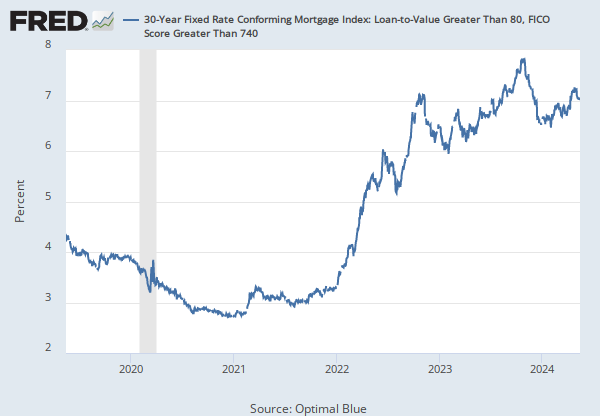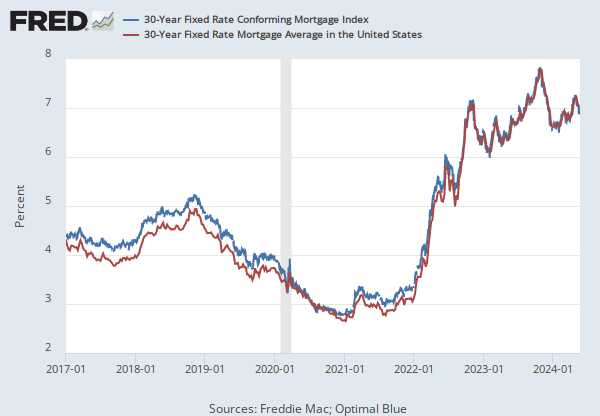FRED Graph
Write a custom formula to transform one or more series or combine two or more series.
You can begin by adding a series to combine with your existing series.
Now create a custom formula to combine or transform the series.
Need help?
For example, invert an exchange rate by using formula 1/a, where “a” refers to the first FRED data series added to this line. Or calculate the spread between 2 interest rates, a and b, by using the formula a - b.
Use the assigned data series variables (a, b, c, etc.) together with operators (+, -, *, /, ^, etc.), parentheses and constants (1, 1.5, 2, etc.) to create your own formula (e.g., 1/a, a-b, (a+b)/2, (a/(a+b+c))*100). As noted above, you may add other data series to this line before entering a formula.
Finally, you can change the units of your new series.
Add the minimum, maximum, and average calculations of selected lines to the graph
Write a custom formula to transform one or more series or combine two or more series.
You can begin by adding a series to combine with your existing series.
Now create a custom formula to combine or transform the series.
Need help?
For example, invert an exchange rate by using formula 1/a, where “a” refers to the first FRED data series added to this line. Or calculate the spread between 2 interest rates, a and b, by using the formula a - b.
Use the assigned data series variables (a, b, c, etc.) together with operators (+, -, *, /, ^, etc.), parentheses and constants (1, 1.5, 2, etc.) to create your own formula (e.g., 1/a, a-b, (a+b)/2, (a/(a+b+c))*100). As noted above, you may add other data series to this line before entering a formula.
Finally, you can change the units of your new series.
Add the minimum, maximum, and average calculations of selected lines to the graph
Write a custom formula to transform one or more series or combine two or more series.
You can begin by adding a series to combine with your existing series.
Now create a custom formula to combine or transform the series.
Need help?
For example, invert an exchange rate by using formula 1/a, where “a” refers to the first FRED data series added to this line. Or calculate the spread between 2 interest rates, a and b, by using the formula a - b.
Use the assigned data series variables (a, b, c, etc.) together with operators (+, -, *, /, ^, etc.), parentheses and constants (1, 1.5, 2, etc.) to create your own formula (e.g., 1/a, a-b, (a+b)/2, (a/(a+b+c))*100). As noted above, you may add other data series to this line before entering a formula.
Finally, you can change the units of your new series.
Add the minimum, maximum, and average calculations of selected lines to the graph
Data in this graph are copyrighted. Please review the copyright information in the series notes before sharing.
Notes
Source: Optimal Blue
Release: Optimal Blue Mortgage Market Indices
Units: Percent, Not Seasonally Adjusted
Frequency: Daily
Notes:
Optimal Blue Mortgage Market Indices™ (OBMMI™) is calculated from actual locked rates with consumers across over one-third of all mortgage transactions nationwide. OBMMI includes multiple mortgage pricing indices developed around the most popular products and specific borrower and loan level attributes.
Each index is calculated as the average of all appropriate rate locks locked through the Optimal Blue product eligibility and pricing engine on a given day. More details about methodology and definitions are available here.
Suggested Citation:
Optimal Blue, 30-Year Fixed Rate Conforming Mortgage Index [OBMMIC30YF], retrieved from FRED, Federal Reserve Bank of St. Louis; https://fred.stlouisfed.org/series/OBMMIC30YF, April 3, 2025.
Source: Optimal Blue
Release: Optimal Blue Mortgage Market Indices
Units: Percent, Not Seasonally Adjusted
Frequency: Daily
Notes:
Optimal Blue Mortgage Market Indices™ (OBMMI™) is calculated from actual locked rates with consumers across over one-third of all mortgage transactions nationwide. OBMMI includes multiple mortgage pricing indices developed around the most popular products and specific borrower and loan level attributes.
Each index is calculated as the average of all appropriate rate locks locked through the Optimal Blue product eligibility and pricing engine on a given day. More details about methodology and definitions are available here.
Suggested Citation:
Optimal Blue, 30-Year Fixed Rate Jumbo Mortgage Index [OBMMIJUMBO30YF], retrieved from FRED, Federal Reserve Bank of St. Louis; https://fred.stlouisfed.org/series/OBMMIJUMBO30YF, April 3, 2025.
Release Tables
Permalink/Embed
modal open, choose link customization options
Select automatic updates to the data or a static time frame. All data are subject to revision.
















